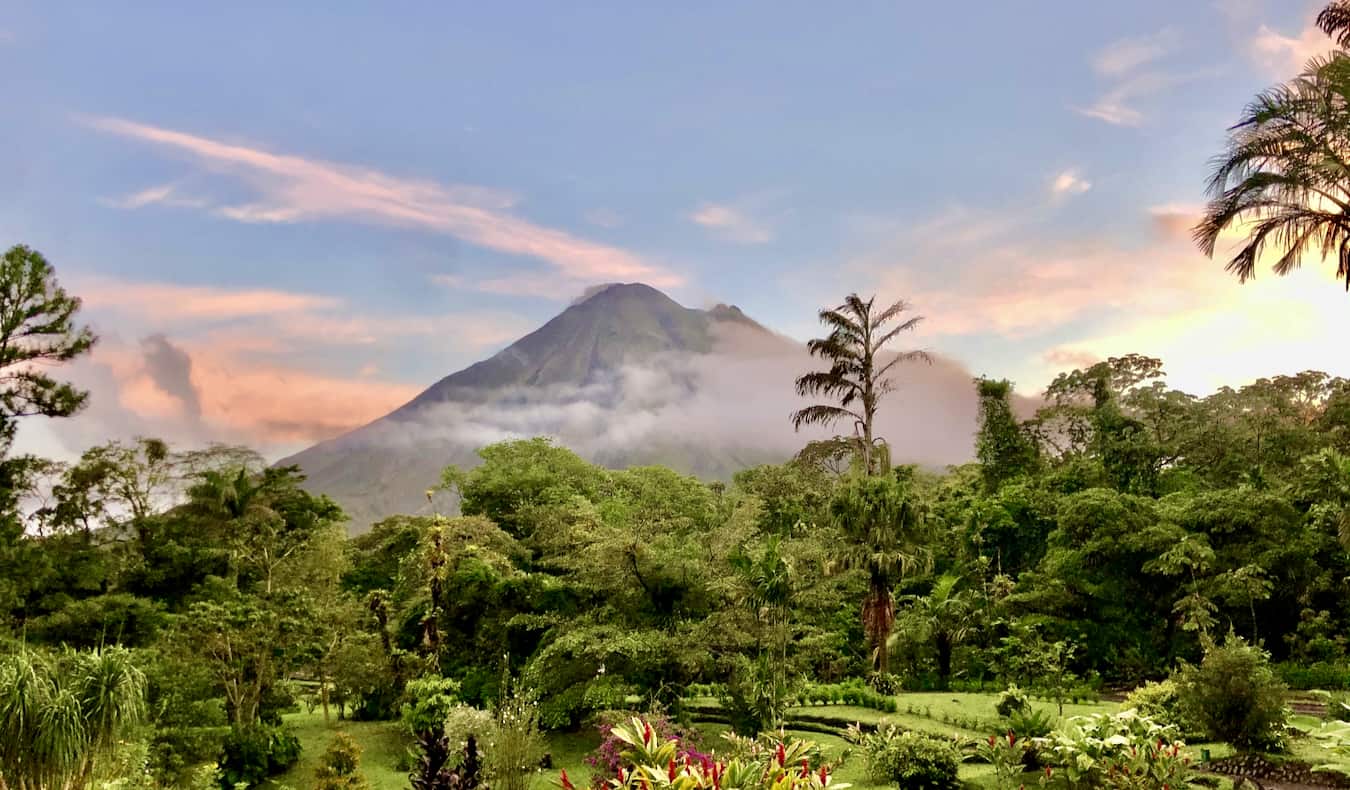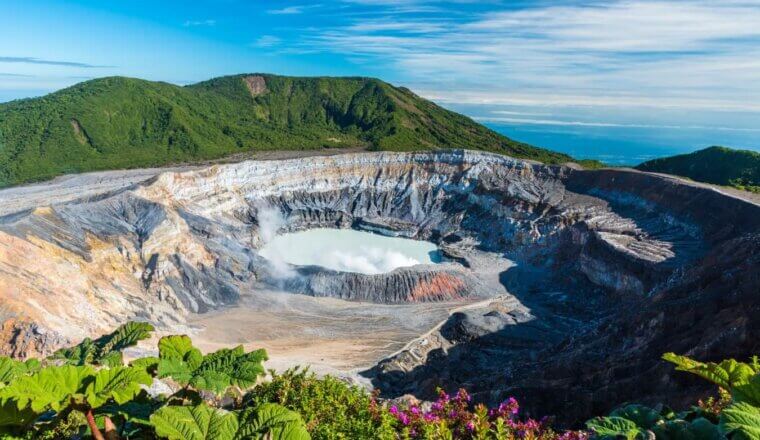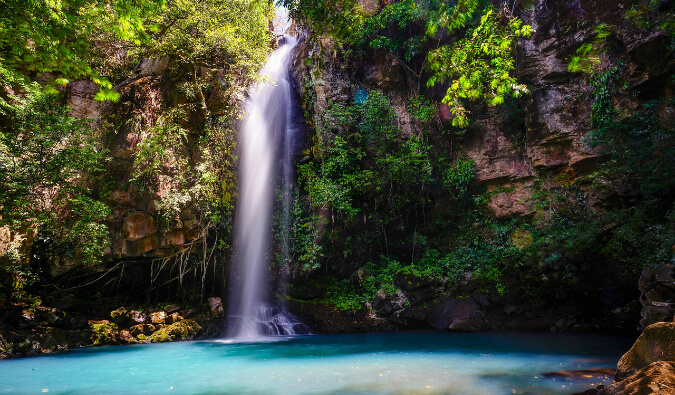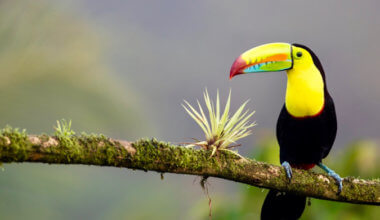
Last Updated: 8/24/23 | August 24th, 2023
Central America is where I started my nomadic life. To this day, it remains one of my favorite regions for backpacking. Flanked by the Pacific and Atlantic Oceans, Central America connects Mexico to South America and is made up of seven countries.
It can be challenging to get around, but the region offers incredible beauty, abundant nature, picturesque beaches, and affordable prices.
And while political upheaval and civil unrest have kept tourists at bay for a long time, these days the area has developed into something of a hotspot for travelers, surfers, and retirees.
Why?
Because Central America has something for everyone yet is still incredibly affordable to travel in.
But is it safe?
In this post, I’ll go over everything you need to know to stay safe and have an amazing trip in this incredibly diverse region!
Table of Contents
- What Countries are in Central America?
- 10 Important Safety Tips for Central America
- What is the Northern Triangle? Is it Safe?
- What is the Safest Country in Central America?
- Is Central America Safe for Solo Travelers?
- Is Central America Safe for Solo Female Travelers?
- Are Taxis Safe in Central America?
- Can You Eat the Street Food in Central America?
- Can You Drink the Tap Water in Central America?
- Is it Safe to Road Trip Through Central America?
What Countries are in Central America?
There are seven countries in Central America:
Click on the map for country guides:
10 Important Safety Tips for Central America
While Central America is generally considered safe for traveling and backpacking, there’s no denying that some precautions should be taken. Petty theft is the most common threat here, so you’ll want to always pay attention to your belongings and take precautions to avoid getting yourself into unwanted situations.
1. Be aware of your surroundings – It can be easy to stop paying attention and let your guard down. But that’s when disaster strikes. Always be aware of your surroundings.
2. Avoid isolated areas – If you’re somewhere isolated, you’ll be at a greater risk for getting robbed, especially at night and in big cities. Try to stay where the crowds are. That’s the best way to avoid being singled out by potential muggers.
3. Don’t wear flashy items – Do your best to blend in so you don’t become a target for pickpockets. Remove any jewelry or watches, and don’t wave your phone around.
4. Separate your cash – Keep only the money that you need for the day on you. Keep the rest locked away safely at your accommodation. That way, if something happens you’ll still have some money tucked away.
5. Download the Prey app to your phone and laptop – If either device gets stolen, you’ll be able to track it and remotely turn on your camera to photograph the thief (you can also wipe the data and message the thief too). It costs just $1.10/month.
6. Take taxis at night – If you need to get somewhere at night, take a taxi. It will be safer than public transportation. Have your accommodation call the taxi for you, so you can be sure you’re getting a reputable driver.
7. Be careful on public transit – If you have to take public transit, keep your valuables on you and keep them well secured, especially on chicken buses (the colorful, modified, and decorated buses that transport goods and people). Petty theft is common on night buses, so avoid them if you can.
8. Don’t do drugs – The cartels here have really made life difficult for the local population. Don’t support them by buying their products. Drug penalties are also harsh in the region, and you don’t want to end up in jail here!
9. Stay away from animals – Stray dogs are common throughout the region, and they (as well as monkeys) often carry diseases, such as rabies (which can be fatal). To avoid getting bitten, don’t pet stray dogs or touch any wild animals.
10. Buy travel insurance – Travel insurance keeps you protected if you get injured or ill, are a victim of theft, or have to deal with delayed or canceled flights. It’s a worthwhile investment and can save you thousands of dollars. Don’t risk traveling without it!
I recommend SafetyWing for travelers under 70, while Insure My Trip is the best choice for travelers over 70.
You can check out this widget to get a quote for SafetyWing:
For more information on travel insurance, check out these posts:
- What Does Travel Insurance ACTUALLY Cover?
- The Best Travel Insurance Companies
- How to Buy the Best Travel Insurance
What is the Northern Triangle? Is it Safe?
The Northern Triangle comprises Guatemala, El Salvador, and Honduras. It’s the region of Central America that traditionally (and currently) has the most crime and violence. This is usually concentrated in the larger cities, and particularly in specific neighborhoods. If you’re going to be in the capital cities of any of these three countries, you’ll want to talk to your hostel or hotel staff for the most up-to-date safety advice.
That said, if you’re visiting tourist areas or going on nature excursions you likely won’t have any issues here as long as you follow the safety advice above.
What is the Safest Country in Central America?
Costa Rica, which provides safety and stability alongside incredible natural beauty. Of course, prices are also much higher and reflect the country’s status as “the Switzerland of Central America.” (There are still ways to travel through the country on a budget though!)
If you’re new to backpacking and want to start off somewhere that offers a good mix of adventure and safety, visit Costa Rica. It was the first country I ever backpacked and I absolutely loved it!
In terms of safety, the next best place is Panama. It’s home to a growing community of expats and retirees, which is giving the country an economic boost and making it a bit more gringo friendly. That means you’ll be able to get lots of great tips and suggestions (including specific local safety tips) from the community while still having yourself an adventure.
Coming in strong behind Panama is Belize. It does a great job of balancing safety with plenty of things to see and do. It’s also quite affordable.
Is Central America Safe for Solo Travelers?
Central America is quite safe for solo travelers. As long as you avoid isolated areas and don’t travel alone at night, you’ll be able to avoid the most common issues tourists face, such as petty crime.
If you’re worried that you won’t feel safe, try to join a group of other travelers (here are the best tours companies in Costa Rica) or invite people from your hostel to join you when you go out. That way, you’ll be able to feel safe while also getting to connect with other people.
As a solo traveler, be sure to scan your passport and other important documents and email them to yourself in case you do happen to run into trouble.
Additionally, be sure to download offline maps and offline language apps so you can look up directions if you get lost or communicate with the locals in an emergency. If you can, try to learn some Spanish before you go too. Even a few key phrases can go a long way!
Is Central America Safe for Solo Female Travelers?
Solo female travelers will need to be more on guard during their time in Central America. Costa Rica, Panama, and Belize are the safest countries in the region. If you’re a new solo female traveler, stick to these countries.
Outside of those three countries, I’d suggest new solo female travelers stick to group travel or tours, just to be safe. However, experienced solo female travelers should be able to navigate the region without too much additional concern.
Women should be extra careful in large cities, though, especially at night. Beyond that, as long as you follow the usual precautions, you’ll be able to have an amazing time!
Are Taxis Safe in Central America?
The taxis in Central America are safe and reliable, though you’ll always want to make sure you’re getting in a marked taxi. Never get in an unmarked car.
During the day, you can hail a taxi from the street safely, but you’ll want to be aware of the local custom, as some countries’ taxis use meters and others require you to negotiate a price in advance.
If taking a taxi at night, have your accommodation call it for you. Never hail a random taxi at night.
Can You Eat the Street Food in Central America?
You bet you can! You’ll find all sorts of amazing street food stands and local restaurants in Central America, and you’d be missing out if you didn’t try them! Just make sure to stick to places where there are a lot of locals gathered. That’s how you know the food is not only safe but delicious too.
For the most part, you’ll encounter places that sell various kinds of chicken. As long as it is fully cooked (not pink on the inside) and hasn’t been in the sun all day, dive in and give it a try! A lot of food here will also be deep-fried, which will almost always be safe (just not healthy).
Don’t hesitate to ask your hotel or hostel staff for street food or restaurant suggestions. They’ll no doubt have some delicious — and perfectly safe — ones for you.
Can You Drink the Tap Water in Central America?
As a general rule, you’ll want to avoid the tap water in Central America, although it’s generally fine in most parts of Costa Rica and Panama.
The best way to make sure your drinking water is safe is to bring a Lifestraw. It’s a reusable bottle with a built-in filter. It allows you to purify the tap water so you don’t get sick while avoiding single-use plastic bottles in the process.
Is it Safe to Road Trip Through Central America?
While it’s safer than it’s ever been to road trip through Central America, not many people do. For one, renting a car is comparatively much more expensive than other transport options for getting around the region.
Second, there still is a very strong perception of the risks and dangers associated with driving here — and not all of it is unfounded. If you plan to road trip in Central America, you do need to take some precautions. Don’t drive after dark, and never leave valuables unattended in your vehicle (even if it’s locked, as thieves can easily break in).
Lastly, roads in the region are not always well-maintained so you should be an experienced driver comfortable with non-optimal road conditions if you plan to drive here.
Personally, I would skip driving and take one of the other plentiful and affordable transportation options. Plus, riding the chicken buses are an essential part of the Central American experience!
If you are going to drive, use Discover Cars to find the best rates on your rental.
With so many affordable accommodations and transportation options, stunning landscapes, plentiful outdoor adventures, and beautiful beaches, it should come as no surprise that Central America is one of the most backpacked regions of the world.
Sure, it might get a bad rap due to its violent history and economic struggles, but that doesn’t mean it’s categorically unsafe. By following the tips above, you’ll be able to stay safe and healthy as you explore this incredible and diverse region.
Book Your Trip to Central America: Logistical Tips and Tricks
Book Your Flight
Use Skyscanner to find a cheap flight. They are my favorite search engine because they search websites and airlines around the globe so you always know no stone is left unturned!
Book Your Accommodation
You can book your hostel with Hostelworld as they have the biggest inventory and best deals. If you want to stay somewhere other than a hostel, use Booking.com as they consistently return the cheapest rates for guesthouses and cheap hotels. My favorite places to stay are:
- Sophie’s Guest Rooms (Caye Caulker, Belize)
- Rocking J’s (Puerto Viejo, Costa Rica)
- Hola Ola Hostel (San Juan del Sur, Nicaragua)
Don’t Forget Travel Insurance
Travel insurance will protect you against illness, injury, theft, and cancellations. It’s comprehensive protection in case anything goes wrong. I never go on a trip without it as I’ve had to use it many times in the past. My favorite companies that offer the best service and value are:
- Safety Wing (best for everyone)
- Insure My Trip (for those over 70)
- Medjet (for additional evacuation coverage)
Looking for the Best Companies to Save Money With?
Check out my resource page for the best companies to use when you travel. I list all the ones I use to save money when I’m on the road. They will save you money when you travel too.
Want More Information on Central America?
Be sure to visit our robust destination guide on Central America for even more planning tips!



